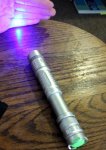- Joined
- Jul 4, 2012
- Messages
- 2,834
- Points
- 63
Wow, I did NOT expect the diode to drop that quickly- I guess I was comparing it to Planters vid where he slowly lowered the temp, though. That'e awesome, thanks for sharing!
I'm sure you could get some sort of air tight "capsule" machined to transfer this to a handheld, but I'm not sure I would want to be waving a canister of liquid nitrogen around. May be better suited for a [stationary] labby type setup
I'm sure you could get some sort of air tight "capsule" machined to transfer this to a handheld, but I'm not sure I would want to be waving a canister of liquid nitrogen around. May be better suited for a [stationary] labby type setup
Last edited:






